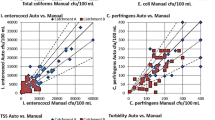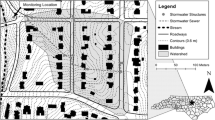Abstract
Storm water runoff is increasingly assessed for fecal indicator organisms (e.g., Escherichia coli, E. coli) and its impact on contact recreation. Concurrently, use of autosamplers along with logistic, economic, technical, and personnel barriers is challenging conventional protocols for sample holding times and storage conditions in the field. A common holding time limit for E. coli is 8 h with a 10 °C storage temperature, but several research studies support longer hold time thresholds. The use of autosamplers to collect E. coli water samples has received little field research attention; thus, this study was implemented to compare refrigerated and unrefrigerated autosamplers and evaluate potential E. coli concentration differences due to field storage temperature (storms with holding times ≤24 h) and due to field storage time and temperature (storms >24 h). Data from 85 runoff events on four diverse watersheds showed that field storage times and temperatures had minor effects on mean and median E. coli concentrations. Graphs and error values did, however, indicate a weak tendency for higher concentrations in the refrigerated samplers, but it is unknown to what extent differing die-off and/or regrowth rates, heterogeneity in concentrations within samples, and laboratory analysis uncertainty contributed to the results. The minimal differences in measured E. coli concentrations cast doubt on the need for utilizing the rigid conventional protocols for field holding time and storage temperature. This is not to say that proper quality assurance and quality control is not important but to emphasize the need to consider the balance between data quality and practical constraints related to logistics, funding, travel time, and autosampler use in storm water studies.



Similar content being viewed by others
References
Allen, P. M., Harmel, R. D., Arnold, J. G., Plant, B., Yeldermann, J., & King, K. W. (2005). Field data and flow system response in clay (vertisol) shale terrain, north central Texas. USA Hydrologic Processes, 19(14), 2719–2736.
American Public Health Association, American Water Works Association, and Water Environment Federation (APHA, AWWA, and WEF). (1998). Standard methods for the examination of water and wastewater (20th ed.). Alexandria: American Public Health Association.
Arnold, J. G., Potter, K. N., King, K. W., & Allen, P. M. (2005). Estimation of soil cracking and the effect on surface runoff in a Texas Blackland Prairie watershed. Hydrological Processes, 19(3), 589–603.
Characklis, G. W., Dilts, M. J., Simmons, O. D., III, Likirdopulos, C. A., Krometis, L. H., & Sobsey, M. D. (2005). Microbial partitioning to settleable particles in stormwater. Water Research, 39, 1773–1782.
Desai, A. M., & Rifai, H. S. (2013). Escherichia coli concentrations in urban watersheds exhibit diurnal sag: implications for water-quality monitoring and assessment. Journal of American Water Resources Association, 49(4), 766–779.
Gupta, H. V., Sorooshian, S., & Yapo, P. O. (1999). Status of automatic calibration for hydrologic models: comparison with multilevel expert calibration. Journal of Hydrological Engineering, 4(2), 135–143.
Haan, C. T. (2002). Statistical methods in hydrology (2nd ed.). Ames: The Iowa State Press.
Harmel, R. D., Cooper, R. J., Slade, R. M., Haney, R. L., & Arnold, J. G. (2006a). Cumulative uncertainty in measured streamflow and water quality data for small watersheds. Transactions of the ASABE, 49(3), 689–701.
Harmel, R. D., King, K. W., Haggard, B. E., Wren, D. G., & Sheridan, J. M. (2006b). Practical guidance for discharge and water quality data collection on small watersheds. Transactions of the ASABE, 49(4), 937–948.
Harmel, R. D., Richardson, C. W., King, K. W., & Allen, P. M. (2006c). Runoff and soil loss relationships for the Texas Blackland Prairies ecoregion. Journal of Hydrology, 331(3–4), 471–483.
Harmel, R. D., Karthikeyan, R., Gentry, T., & Srinivasan, R. (2010). Effects of agricultural management, land use, and watershed scale on E. coli concentrations in runoff and streamflow. Transactions of the ASABE, 53(6), 1833–1841.
Harmel, R. D., Wagner, K. L., Martin, E., Gentry, T. J., Karthikeyan, R., Dozier, M., & Coufal, C. (2013). Impact of poultry litter application and land use on E. coli runoff from small agricultural watersheds. Biological Engineering Transactions, 6(1), 3–16.
Harmel, R. D., Hathaway, J. M., Wagner, K. L., Wolfe, J. E., Karthikeyan, R., Francesconi, W., & McCarthy, D. T. (2015). Uncertainty in monitoring E. coli concentrations in streams and stormwater runoff. Journal of Hydrology, 534, 524–533. doi:10.1016/j.jhydrol.2016.01.040.
Hathaway, J. M., Hunt, W. F., & Simmons, O. D., III. (2010). Statistical evaluation of factors affecting indicator bacteria in urban storm-water runoff. Journal of Environmental Engineering, 136(12), 1360–1368.
Helsel, D. R., & Hirsch, R. M. (1993). Statistical methods in water resources. New York: Elsevier.
Jamieson, R. C., Joy, D. M., Lee, H., Kostaschuk, R., & Gordon, R. J. (2005). Resuspension of sediment-associated Escherichia coli in a natural stream. Journal of Environmental Quality, 34, 581–589.
JMP. (2012). JMP version 10: using JMP. Cary: SAS Institute.
McCarthy, D. T., Deletic, A., Mitchell, V. G., Fletcher, T. D., & Diaper, C. (2008). Uncertainties in stormwater E. coli levels. Water Research, 42(6–7), 1812–1824.
McCarthy, D. T., Bach, P. M., & Deletic, A. (2009). Conducting a bacterial budget: a literature review. Melbourne: Melbourne Water.
Minitab. (2015). MINITAB 17. State College: Minitab Inc.
Moriasi, D. N., Arnold, J. G., Van Liew, M. W., Bingner, R. L., Harmel, R. D., & Veith, T. L. (2007). Model evaluation guidelines for systematic quantification of accuracy in watershed simulations. Transactions of the ASABE, 50(3), 885–900.
Pachepsky, Y. A., Blaustein, R. A., Whelan, G., & Shelton, D. R. (2014). Comparing temperature effects on Escherichia coli, Salmonella, and Enterococcus survival in surface waters. Letters of Applied Microbiology, 59, 278–283.
Pope, M. L., Bussen, M., Feige, M. A., Shadix, L., Gonder, S., Rodgers, C., Chambers, Y., Pulz, J., Miller, K., Connell, K., & Standridge, J. (2003). Assessment of the effects of holding time and temperature on Escherichia coli densities in surface water samples. Applied and Environmental Microbiology, 69(10), 6201–6207.
Selvakumar, A., & Borst, M. (2004). Effects of sample holding time on concentrations of microorganisms in water samples. Water Environment Research, 16(1), 67–72.
Selvakumar, A., & Borst, M. (2006). Variation of microorganism concentrations in urban stormwater runoff with land use and seasons. Journal of Water and Health, 4(1), 109–124.
Solo-Gabriele, H. M., Wolfert, M. A., Desmarais, T. R., & Palmer, C. J. (2000). Sources of Escherichia coli in a coastal subtropical environment. Applied and Environmental Microbiology, 66, 230–237.
TCEQ. (2008). E coli holding time study report. Austin: Texas Commission on Environmental Quality.
TCEQ. (2014). Surface water quality monitoring program, water quality standards program, and water quality assessment program, quality assurance project plan. Austin: Texas Commission on Environmental Quality.
USEPA. (2006a). Method 1603: Escherichia coli (E. coli) in water by membrane filtration using modified membrane-thermotolerant escherichia coli agar (Modified mTEC). EPA-821-R-06-011. Washington, DC: Environmental Protection Agency, Office of Water.
USEPA. (2006b). Assessment of the effects of holding time and enterococci concentrations in fresh and marine recreational waters and escherichia coli concentrations in fresh recreational waters. EPA-821-R-06-019. Washington, DC: Environmental Protection Agency, Office of Water.
USEPA. (2014). National summary of impaired waters and TMDL information. Available: http://iaspub.epa.gov/waters10/attains_nation_cy.control?p_report_type=T (accessed April 2014).
Wagner, K. L., Redmon, L. A., Gentry, T. J., & Harmel, R. D. (2012). Assessment of cattle grazing effects on E. coli runoff. Transactions of the ASABE, 55(6), 2111–2122.
Wagner, K. L., Redmon, L. A., Gentry, T. J., Harmel, R. D., Knight, R., Jones, C. A., & Foster, J. L. (2013). Effects of an off-stream watering facility on cattle behavior and instream E. coli levels. Texas Water Journal, 4(2), 1–13.
Acknowledgments
Funding for this project was provided by USDA-ARS, USEPA Region 6, and the Texas State Soil and Water Conservation Board. USDA-ARS technicians at Riesel (Kyle Tiner, Gary Hoeft, and Larry Koester) and Texas A&M laboratory technicians (Heidi Mjelde) deserve credit for their outstanding technical support.
Author information
Authors and Affiliations
Corresponding author
Additional information
The USDA is an equal opportunity provider and employer.
Mention of trade names or commercial products is solely for the purpose of providing specific information and does not imply recommendation or endorsement by the USDA.
Rights and permissions
About this article
Cite this article
Harmel, D., Wagner, K., Martin, E. et al. Effects of field storage method on E. coli concentrations measured in storm water runoff. Environ Monit Assess 188, 170 (2016). https://doi.org/10.1007/s10661-016-5183-9
Received:
Accepted:
Published:
DOI: https://doi.org/10.1007/s10661-016-5183-9




